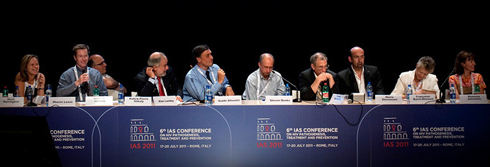August
1, 2011—The search for an HIV cure has moved to center stage in the field of AIDS
research, with newfound optimism fueled in part by the first ever cure of HIV
through a stem cell transplant in “the Berlin patient.” Yet many of the central
questions that will determine the future course and outcome of cure-focused
research are the subject of contentious debate.
On July 18, amfAR’s Vice President and Director of Research Dr. Rowena Johnston co-chaired “Controversies in HIV Cure Research,” a debate organized in conjunction with the 6th IAS Conference on HIV Pathogenesis, Treatment and Prevention. Along with her co-chair, Nobel Prize winner Dr. Françoise Barré-Sinoussi of the Pasteur Institute, Johnston led a lively discussion.

The “Controversies in HIV Cure Research” debate was co-chaired by amfAR’s Vice President and Director of Research Dr. Rowena Johnston (right) and Nobel Prize winner Dr. Françoise Barré-Sinoussi (second from right).
In
the first of three mini-debates, amfAR grantee Dr. Steve Deeks of the
University of California, San Francisco, moderated a discussion between Dr.
Mario Stevenson of the University of Miami Medical School and Dr. Frank
Maldarelli of the National Cancer Institute. The question was: Does HIV
continue to replicate even after antiretroviral therapy has suppressed it below
levels of normal detection, or does it remain latent, possibly in immune cells
with longer half-lives than the oft-targeted but relatively short-lived T
cells?
Dr.
Stevenson, chair of amfAR’s Scientific Advisory Committee, postulated that HIV
does indeed replicate on an ongoing basis, even when a patient is under HAART.
Dr. Maldarelli, on the other hand, found no evidence of ongoing replication in
his research though he remained open to the possibility. Both agreed that
better tests are needed to answer the question definitively, and that the
outcome might dictate which strategies are most likely to cure HIV.
“There is a lot to learn from animal studies, but I would like to see intervention testing in humans as quickly as possible.”
Dr.
Alan Landay of Rush University Medical Center and Dr. Guido Silvestri of Emory
University then debated the merits of primate versus human testing in cure
research. Dr. Landay, also a member of amfAR’s Scientific Advisory Committee,
argued that primates do not provide information as useful as human subjects
because SIV, a virus that infects primates and is similar to HIV in many ways,
is different in several critical respects. “We really have had in the human
model the proof of concept of … a cure in the Berlin patient,” Dr. Landay said.
Dr. Rafick Sekaly, the moderator and another former amfAR grantee, added,
“There is a lot to learn from animal studies, but I think I would like to see
intervention testing in humans as quickly as possible…There’s not a single
animal model that can replicate the human condition.”
The
case for primate models rested with Dr. Silvestri, who said, “Maybe this is the
best animal model for a human disease that we have ever had.” He named past
successes in the field of HIV research that stemmed from work with primates,
including pre-trial tests on microbicides, vaccines, and HAART. “I think we
learn so much in the field of AIDS research by doing studies in monkeys,” said
Dr. Silvestri.
The
final debate of the evening, on the likeliest source of a cure, pitted Dr.
Sharon Lewin of Monash University in Melbourne against Dr. Keith Jerome of the
University of Washington and was moderated by Mark Harrington of Treatment
Action Group. Dr. Lewin argued the merits of drug treatment, as opposed to gene
therapy. “Pharmacotherapy has the potential to be scalable, deliverable, and
cheap,” she said, “and I think we need to keep in mind that [the developing
world] is where HIV care is delivered to 90 percent of HIV-infected patients.”
Dr.
Jerome agreed that any found cure must be scalable and deliverable to all who
need it, but focused on gene therapy as the fastest way to a cure, again
referring to the Berlin patient. “I think the principle’s been proven in the
only cure to date that we can point at, and I think this is an approach that’s
ready to go.”
Wrapping up, Dr. Barré-Sinoussi said,
“From the technology that we have, it’s really difficult to say that gene
therapy is the path for the cure. We cannot say that today.” Looking to the
future, however, she added, “But who knows what we will say tomorrow or the day
after tomorrow. We don’t know.”